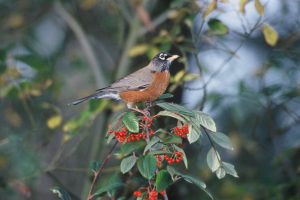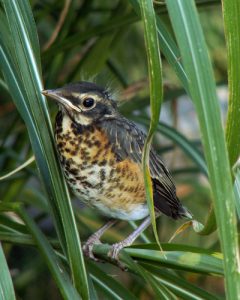American Robin Fact Sheet

Present throughout North America, the American Robin is one of the most widely recognized birds. Although it is typically thought of as a forest and woodland resident, it adapts to a wide range of habitats, and is very common in suburban yards and parks, and even urban areas. You may have found a nest at some point in your neighborhood.
Signs of the Seasons observers are contributing phenology data to monitor for possible changes in the timing of robins’ annual life cycle events in response to a changing climate.

Appearance: The distinguishing feature of the American Robin is its red-orange belly. Both male and female adults have gray backs. The head of the female robin is also gray, while the male’s head is dark gray to black. The juvenile Robin has a spotted belly as well as some spotting throughout the wings. Both adults and juveniles have yellow bills. Adults grow to be about 9 to 11 inches from beak to tail.
Feeding: The American Robin is an omnivore with a diet that includes earthworms, caterpillars, and insects, as well as fruits and berries. The proportion of each that an individual consumes depends upon availability.

Life History: The American Robin can be found throughout the US, as well as much of Canada and northern Mexico. The American Robin is a migratory bird, responding to changes in temperature and food availability with seasonal north-south movements. Canada typically has only summer (breeding) populations, while northern Mexico and some southern states will have only over-wintering populations. There are some populations of Robins that have been found to remain close to their breeding grounds year-round, retreating to roosting sites in trees during the winter months and becoming more visible as the temperature warms and they venture back down to the ground to forage and prepare for breeding. Females immediately start nest building upon return to the breeding grounds, and they start to lay their first eggs (characteristically pale blue in color) within days of finishing the nest, laying one egg every 3 to 4 days. The incubation time for the eggs is about 12 to 14 days, and the eggs hatch in the order they were laid. The mother and father tend their nestlings together until they fledge at about two weeks of age. Parents continue to care for the fledglings for about another two weeks, at which time they are largely independent. The male does most of the care for the fledglings at this stage, as the female is busy getting ready for a second brood. She may have up to 3 broods each season.
Sources and Additional Information:
USA Phenology Network — Observing Plants and Animals, http://www.usanpn.org/Turdus_migratorius
The Cornell Lab of Ornithology All About Birds, http://www.allaboutbirds.org/guide/American_Robin/id
Smithsonian National Zoological Park Migratory Bird Center — American Robin: The Suburban Bird, http://nationalzoo.si.edu/scbi/migratorybirds/featured_birds/default.cfm?bird=American_Robin
US Fish and Wildlife Service National Digital Library, http://digitalmedia.fws.gov/index.php
Journey North: A Global Study of Wildlife Migration and Seasonal Change — American Robin, http://www.learner.org/jnorth/robin/index.html
